
India fast-tracks BrahMos-II hypersonic missile development after Operation Sindoor success
BrahMos-II hypersonic missile- India’s defense landscape is undergoing a transformational shift, with the country rapidly advancing its hypersonic missile capabilities. Following the resounding success of BrahMos strikes during Operation Sindoor, India has intensified efforts to develop BrahMos-II, a next-generation hypersonic cruise missile capable of reaching speeds between Mach 6 and Mach 8. This breakthrough positions India among the elite nations pursuing hypersonic weaponry, alongside the United States, Russia, and China.
The BrahMos-II missile, jointly developed by India and Russia, is designed to neutralize high-value targets with unmatched speed and precision. Unlike conventional cruise missiles, hypersonic missiles travel at speeds exceeding Mach 5, making them extremely difficult to intercept. With global military tensions rising, hypersonic technology is becoming a strategic necessity, ensuring rapid response capabilities and unparalleled deterrence.
The Strategic Importance of BrahMos-II
The BrahMos-II missile is set to revolutionize modern warfare, offering unprecedented speed, stealth, and precision. As India strengthens its defense infrastructure, BrahMos-II will serve as a critical asset in safeguarding national security.
Key Features of BrahMos-II
- Speed: Mach 6-8 (six to eight times the speed of sound)
- Range: Up to 1,500 km
- Engine: Scramjet propulsion, an upgrade over the ramjet system used in the current BrahMos missile
- Design Influence: Inspired by Russia’s Zircon missile, which can reach Mach 9
- Multi-platform Compatibility: Can be launched from land, sea, air, and submarines
Operation Sindoor: A Turning Point
India’s Operation Sindoor was a decisive military strike targeting terror infrastructure in Pakistan and Pakistan-Occupied Kashmir (PoK). The BrahMos missile played a pivotal role, successfully neutralizing all intended targets with its fire-and-forget capability.
Following this success, India has intensified its focus on hypersonic missile technology, aiming to strengthen its strategic deterrence against adversaries.
India’s Hypersonic Missile Development: A Global Perspective
The race for hypersonic supremacy is heating up, with major military powers investing heavily in next-generation missile systems. India’s BrahMos-II project aligns with global trends, ensuring technological dominance in the aerospace and defense sectors.
Challenges in Hypersonic Missile Development
Despite the promising advancements, India faces several technical and geopolitical challenges:
- Missile Technology Control Regime (MTCR) Restrictions: Initially limited India’s access to hypersonic technology from Russia.
- High Development Costs: Hypersonic missiles require advanced materials to withstand extreme temperatures.
- Precision Navigation: Ensuring accurate targeting at hypersonic speeds remains a complex engineering challenge.
Future Prospects: What’s Next for BrahMos-II?
India’s Defence Research and Development Organisation (DRDO) recently achieved a breakthrough by successfully testing a scramjet combustor for over 1,000 seconds. This milestone signals India’s readiness to enter the hypersonic missile league.
Expected Timeline
- 2025: Finalization of technical collaboration with Russia
- 2027–2028: First flight test of BrahMos-II
- 2030: Full operational deployment
Conclusion – BrahMos-II hypersonic missile
India’s BrahMos-II hypersonic missile represents a game-changing advancement in modern warfare. With unparalleled speed, precision, and stealth capabilities, it will redefine India’s defense strategy and fortify national security. As global tensions rise, hypersonic weapons will play a critical role in shaping the future of military engagements.
India’s commitment to indigenous defense technology is evident in its Atmanirbhar Bharat initiative, ensuring self-reliance in military advancements. With BrahMos-II, India is not just keeping up with the hypersonic race—it is competing at the highest level, reinforcing its position as a global defense powerhouse.
1 thought on “India Accelerates BrahMos-II Hypersonic Missile Development After Operation Sindoor Triumph”